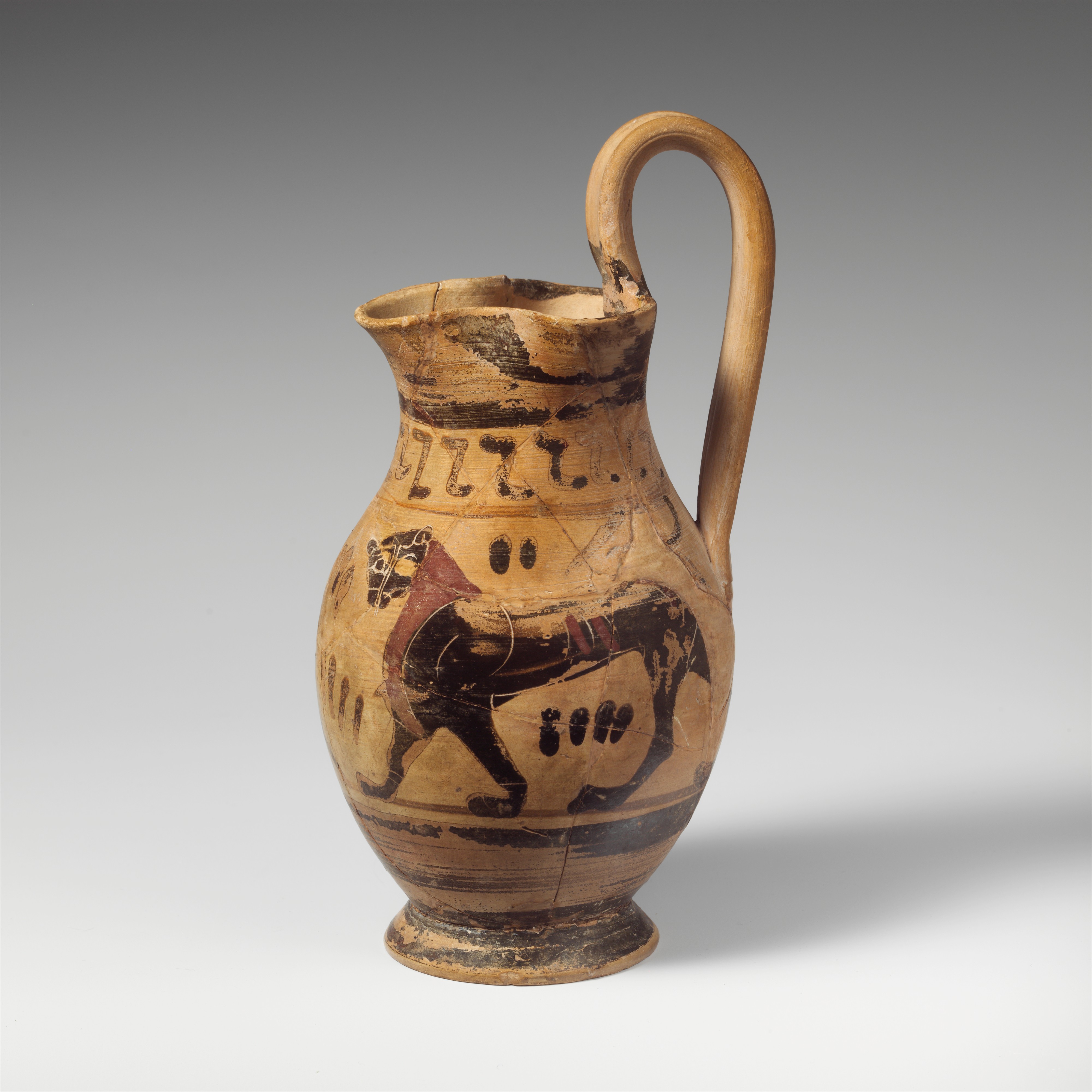-
 Attic Black Figure Oinochoe
Attic Black Figure OinochoeM10 Cat. Att App. 3
Pottery
Ceramic
Ca. 500-480 BC (Late Lydian (Persian))
Chase, "Field Notes": "On neck, simple maeander, bordered above and below by a single line; on shoulder, ... tongue pattern bordered above and below by a single line, and defining top of main field; at either side of main field, three vertical lines ...
-
 Attic Black Figure Oinochoe Fragments
Attic Black Figure Oinochoe FragmentsM10 Cat. Att App. 4
Pottery
Ceramic
()
Two fragments. Only a small bit of the painted design is preserved: vertical black bands with dots between them, from the border of a reserved panel on the body of a trefoil oinochoe.
-
 Attic Black Figure Olpe
Attic Black Figure OlpeM10 Cat. Att App. 5
Pottery
Ceramic
Ca. 560-540 BC (Lydian)
Restored from many fragments; complete except for small pieces of the rim and body. Two panthers, walking on a ground line are confronted at either side of a stylized lotus flower. Their heads face front. The tail of each curls up and "disappears" be...
-
 Attic Black Figure Lekythos
Attic Black Figure LekythosM10 Cat. Att App. 6
Pottery
Ceramic
Ca. 530 BC (Late Lydian (Persian))
Mended from many fragments; parts of upper body, shoulder, lower neck missing and restored in plaster. Quadriga to right and three figures. A bearded charioteer in a long tunic mounts a chariot and holds the reins. Facing him is a standing warrior ho...
-
 Attic Black Figure Lekythos
Attic Black Figure LekythosM10 Cat. Att App. 7
Pottery
Ceramic
()
Complete and unbroken. Black glaze on the foot, lower body, handle, and rim. Chase, "Field Notes": " On shoulder, double row of tongues. On body, fine hard yellowish white slip, bordered above and below by a narrow brown-black stripe and decorated wi...
-
 Attic Black Figure Lekythos
Attic Black Figure LekythosM10 Cat. Att App. 8
Pottery
Ceramic
()
Local imitation of Attic black figure. Chase, "Field Notes": "Buff clay, light buff slip; body, foot, and handle covered with poor black varnish. At top of body, two stripes in red overcolor, about middle of body, one stripe. On shoulder, two bands o...
-
 Attic Black Figure Lekythos
Attic Black Figure LekythosM10 Cat. Att App. 9
Pottery
Ceramic
()
Not certainly Attic. Chase, "Field Notes": "On neck, two rows of tongue pattern. On upper part of body, over white slip, three enclosed palmettes placed on their sides between narrow bands; below, broad band of black varnish. Lower part of body and f...
-
 Attic Black Figure Krater Fragment
Attic Black Figure Krater FragmentM10 Cat. Att App. 10
Pottery
Ceramic
late 6th C. BC ()
Neck and shoulder fragment. Black glaze at the neck, maeander at top of the shoulder, black glaze on the interior.
-
 Attic Black Figure Lekanis (?)
Attic Black Figure Lekanis (?)M10 Cat. Att App. 11
Pottery
Ceramic
()
Not certainly Attic. Chase, “Field Notes”: “Buff clay, fine black and red varnish, rather thinly applied in places, so that the effect resembles the streaked technique. Edge of foot and flat lip of bowl ‘spared’ [i.e., reserved]. Hollow inside of ste...
-
 Attic Black Figure Lip Cup Fragment
Attic Black Figure Lip Cup FragmentM10 Cat. Att App. 12
Pottery
Ceramic
Ca. 550-525 BC (Late Lydian (Persian))
Fragment of lower part of a cup. Exterior: black band, with reserved band on either side, and black-glazed area near the stem. Trace of a letter in the handle zone. Interior: black glaze and small part of reserved tondo.
-
 Attic Black Figure Cup Fragment
Attic Black Figure Cup FragmentM10 Cat. Att App. 13
Pottery
Ceramic
Ca. 500-475 BC (Late Lydian (Persian))
Fragment. A central vine flanked by two women seated beside baskets. Two glazed lines beneath the scene. Incision on the drapery and baskets. Formless style, like the Leafless Group, and poor glaze.
-
 Attic Black Figure Cup Fragments
Attic Black Figure Cup FragmentsM10 Cat. Att App. 14
Pottery
Ceramic
()
Not certainly Attic. Thick walls, offset rim, and heavy handles. Chase, "Field Notes": "Buff clay, fine black and red varnish applied in parts so as to give the effect of streaked technique. Exterior: near bottom of bowl, broad 'spared' band, decorat...